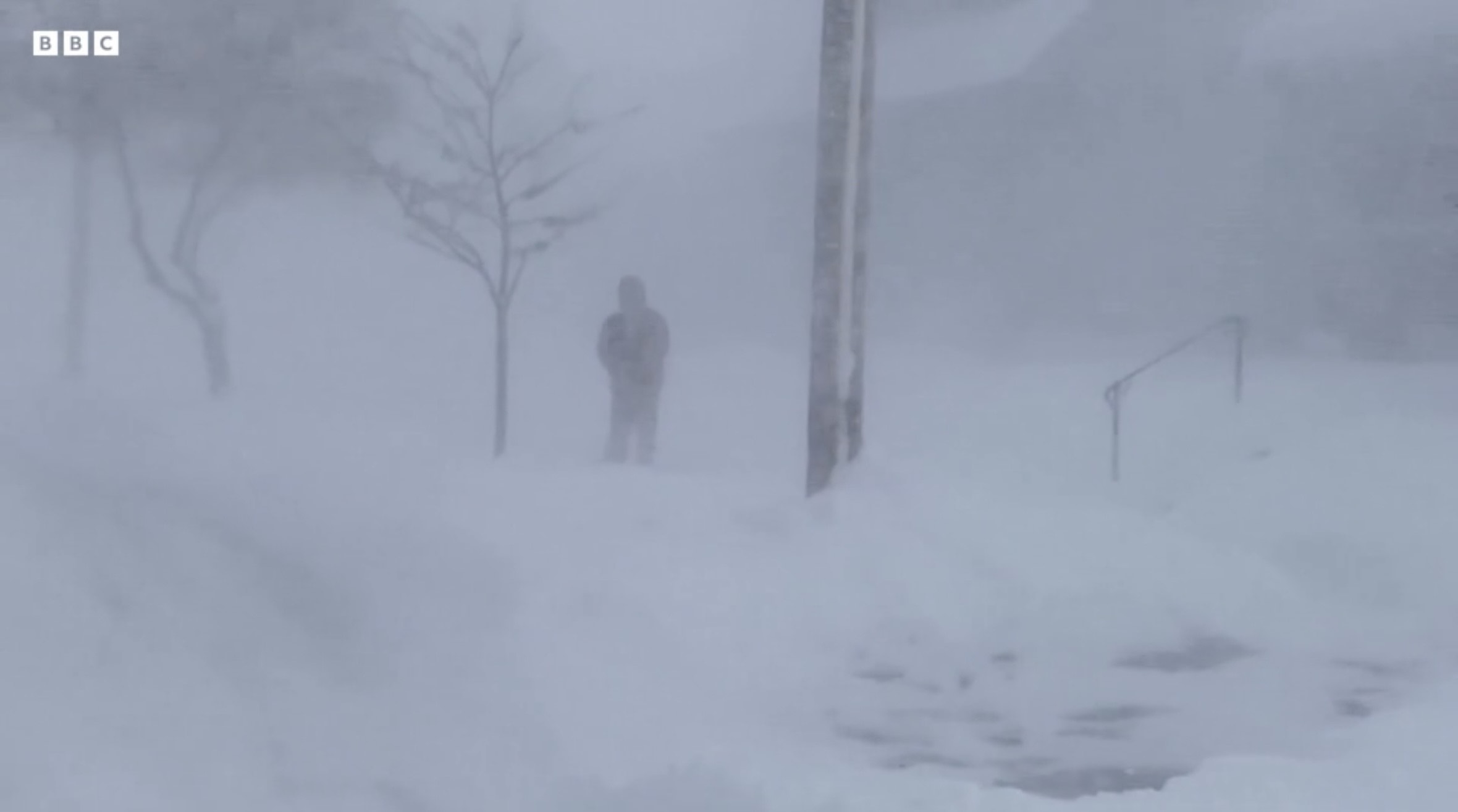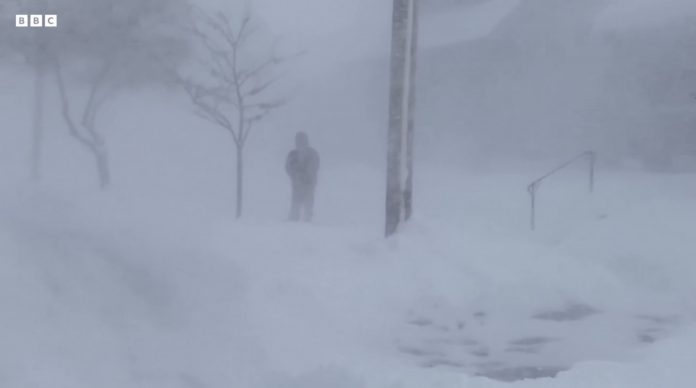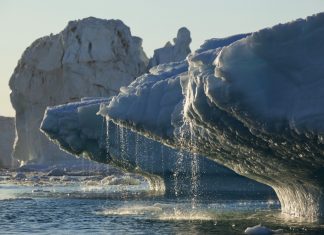ชาวอเมริกันกว่า 60 ล้านคนกำลังอยู่ภายใต้คำเตือนภัยสภาพอากาศฤดูหนาว เนื่องจากพายุฤดูหนาวขนาดใหญ่ที่คาดว่าจะนำมาซึ่งหิมะตกหนักที่สุดและอุณหภูมิเย็นที่สุดในรอบกว่าสิบปี
พื้นที่ส่วนใหญ่ของแคนาดาและ 30 รัฐในสหรัฐฯ ตั้งแต่รัฐแคนซัสถึงชายฝั่งตะวันออกอยู่ภายใต้คำเตือนภัยสภาพอากาศตามรายงานของสำนักงานพยากรณ์อากาศแห่งชาติสหรัฐฯ (NWS) โดยคาดว่าหิมะจะตกหนา 6-12 นิ้ว (15-30 ซม.) ตั้งแต่รัฐโอไฮโอถึงกรุงวอชิงตัน ดี.ซี.
รัฐเคนทักกี เวอร์จิเนีย เวสต์เวอร์จิเนีย แคนซัส อาร์คันซอ และมิสซูรี ได้ประกาศสถานการณ์ฉุกเฉิน แม้แต่บางส่วนของรัฐฟลอริดาซึ่งปกติจะมีสภาพอากาศอบอุ่น ก็ยังคาดว่าจะเผชิญกับอุณหภูมิเยือกแข็ง
นักพยากรณ์อากาศกล่าวว่าสภาพอากาศรุนแรงครั้งนี้เกิดจาก Polar Vortex หรือกระแสอากาศเย็นที่หมุนวนรอบขั้วโลกเหนือ
หลังจากพายุพัดผ่านพื้นที่พื้นที่ราบตอนกลางของสหรัฐฯ พายุจะมุ่งหน้าสู่ชายฝั่งตะวันออกของสหรัฐฯ ภายในเย็นวันอาทิตย์
กรุงวอชิงตัน ดี.ซี. กำลังเตรียมรับมือกับหิมะหนา 5-9 นิ้ว โดยนายกเทศมนตรีของเมืองได้ประกาศสถานการณ์ฉุกเฉินด้านหิมะจนถึงเย็นวันอาทิตย์
สภาคองเกรสมีกำหนดประชุมในบ่ายวันจันทร์เพื่อรับรองชัยชนะของโดนัลด์ ทรัมป์ ในการเลือกตั้งประธานาธิบดีเมื่อสามเดือนก่อน แต่ยังไม่แน่ชัดว่าสภาพอากาศเลวร้ายจะทำให้สมาชิกสภาบางส่วนกลับมายังกรุงวอชิงตันล่าช้าหรือไม่
พื้นที่แอนนาโพลิส ใกล้กับเมืองบัลติมอร์ รัฐแมริแลนด์ อาจมีหิมะตกหนาถึง 8-12 นิ้ว ตามการพยากรณ์ของ NWS
คำเตือนพายุหิมะได้ถูกประกาศในรัฐแคนซัส มิสซูรี และเนแบรสกา
ส่วนหนึ่งของพื้นที่ทางตอนเหนือของรัฐมิสซูรีมีหิมะและน้ำแข็งตกสะสมแล้วถึง 14 นิ้ว ขณะที่รัฐแคนซัสมีหิมะหนาถึง 10 นิ้ว
“สำหรับพื้นที่ในภูมิภาคนี้ที่มีปริมาณหิมะตกสะสมมากที่สุด อาจเป็นหิมะที่ตกหนักที่สุดในรอบอย่างน้อยสิบปี” NWS กล่าวในวันอาทิตย์
แดน เดอโปด์วิน นักพยากรณ์อากาศจาก AccuWeather กล่าวว่า “สภาพอากาศครั้งนี้อาจนำไปสู่เดือนมกราคมที่หนาวที่สุดของสหรัฐฯ ตั้งแต่ปี 2011”
เขาเสริมว่า “อุณหภูมิที่ต่ำกว่าค่าเฉลี่ยในประวัติศาสตร์อย่างมาก” อาจคงอยู่ต่อเนื่องเป็นเวลาหนึ่งสัปดาห์ โดยคาดว่าอุณหภูมิจะต่ำกว่าปกติ 12-25 องศาฟาเรนไฮต์ (7-14 องศาเซลเซียส)
การเดินทางคาดว่าจะล่าช้าอย่างหนัก มีเที่ยวบินเกือบ 1,500 เที่ยวในและนอกสหรัฐฯ ถูกยกเลิก และอีกเกือบ 5,000 เที่ยวล่าช้า ตามข้อมูลจากเว็บไซต์ FlightAware.com
บริการรถไฟ Amtrak ก็ได้ยกเลิกหลายเที่ยวเช่นกัน
สายการบินอเมริกัน แอร์ไลน์ เดลตา เซาท์เวสต์ และยูไนเต็ด ได้ยกเว้นค่าธรรมเนียมการเปลี่ยนแปลงเที่ยวบินให้ผู้โดยสาร เนื่องจากอาจเกิดความล่าช้าในการเดินทาง
ในส่วนทางเหนือขึ้นไป ชาวแคนาดาก็ได้รับผลกระทบจาก Polar Vortex เช่นกัน
พื้นที่ส่วนใหญ่ของแคนาดาอยู่ภายใต้คำเตือนสภาพอากาศรุนแรงในสุดสัปดาห์นี้ โดยอุณหภูมิหนาวเย็นแผ่ปกคลุมไปทั่วประเทศ
บางพื้นที่ยังต้องเผชิญกับ Snow Squalls หรือหิมะตกหนักแบบฉับพลันที่มาพร้อมกับลมแรง
ในจังหวัดแมนิโทบา ทางตอนกลางของแคนาดา อุณหภูมิอาจลดต่ำลงถึง -40 องศาเซลเซียส เมื่อรวมกับความหนาวจากลมพัด
ขณะเดียวกัน บางส่วนของออนแทรีโออาจมีหิมะตกหนาถึง 15 นิ้วในวันอาทิตย์
สภาพถนนได้เริ่มเสื่อมสภาพลง เนื่องจากมีรายงานอุบัติเหตุจากรถบรรทุกและรถยนต์ รวมถึงรถดับเพลิงที่พลิกคว่ำใกล้เมืองซาลินา รัฐแคนซัส
“NWS เตือนว่า สภาพอากาศที่มองไม่เห็นทางจะทำให้การเดินทางเป็นอันตรายอย่างยิ่ง โดยถนนอาจไม่สามารถผ่านได้ และมีความเสี่ยงสูงที่ผู้ขับขี่อาจติดค้างอยู่กลางทาง”
ขณะเดียวกัน พายุฝนฟ้าคะนองรุนแรงที่อาจทำให้เกิดพายุทอร์นาโดจะเคลื่อนตัวไปทางตะวันออกจากรัฐอาร์คันซอและหลุยเซียนา ไปยังมิสซิสซิปปีและแอละแบมาในเย็นวันอาทิตย์ ตามรายงานของ NWS
ไรอัน มัว นักพยากรณ์อากาศเอกชนกล่าวว่า “สถานการณ์จะวุ่นวายและอาจเป็นภัยพิบัติได้ นี่เป็นสิ่งที่เราไม่ได้เห็นมานาน”
Here’s what to know about winter storm pummeling North America

More than 60 million Americans are under winter weather alerts as a huge winter storm is forecast to bring the heaviest snowfall and coldest temperatures in over a decade.
Much of Canada and 30 US states from Kansas to the East Coast are under weather alerts, the National Weather Service (NWS) said. Snowfall of 6-12in (15-30cm) is expected from Ohio to Washington DC.
A state of emergency has been declared in Kentucky, Virginia, West Virginia, Kansas, Arkansas and Missouri. Even parts of normally balmy Florida are expected to experience freezing conditions.
Forecasters say the extreme weather is being caused by the polar vortex, an area of cold air that circulates around the Arctic.
After blanketing the Central Plains, the storm is expected to hit the US East Coast by Sunday evening.
Washington DC is bracing for between 5-9in of snow. The city’s mayor has declared a snow emergency until at least Sunday evening.
Congress is due to meet on Monday afternoon to certify Donald Trump’s victory in the US presidential election three months ago, but it is unclear if the foul weather could delay some lawmakers returning to the capital from their constituencies.
The Annapolis area near Baltimore, Maryland, could see 8-12in of snow, the NWS predicts.
Blizzard warnings have been issued in Kansas, Missouri and Nebraska.
Parts of northern Missouri have already experienced 14in of sleet and snow, while Kansas has had 10in.
“For locations in this region that receive the highest snow totals, it may be the heaviest snowfall in at least a decade,” the NWS said on Sunday.
AccuWeather forecaster Dan DePodwin said: “This could lead to the coldest January for the US since 2011.”
He added that “temperatures that are well below historical average” could linger for a week. Temperatures 12-25F (7-14C) below normal are forecast.
Severe travel delays are expected. Nearly 1,500 flights into and out of the US have been cancelled and nearly 5,000 more delayed, according to FlightAware.com.
Amtrak has also cancelled numerous train services.
American, Delta, Southwest and United airlines are waiving change fees for passengers because of the potential flight disruptions.
Further north, Canadians are also feeling the effects of the polar vortex.
Much of Canada is under extreme weather alerts this weekend with frigid temperatures spanning the country.
Some areas are also seeing snow squalls – a sudden heavy snowfall accompanied by strong winds.
In the central province of Manitoba, the wind chill could see temperatures plummet to as low as -40C.
Meanwhile, parts of Ontario could see as much as 15in of snow on Sunday.
Conditions on roads have already deteriorated, with crashes involving lorries and cars, as well as a fire engine rolling over near Salina, Kansas.
“Whiteout conditions will make travel extremely hazardous, with impassable roads and a high risk of motorists becoming stranded,” the NWS warned.
Meanwhile, severe thunderstorms capable of producing tornadoes will move east from Arkansas and Louisiana into Mississippi and Alabama on Sunday evening, the NWS said.
Private meteorologist Ryan Maue said: “It’s going to be a mess, a potential disaster. This is something we haven’t seen in quite a while.”
By Ana Faguy, BBC

















